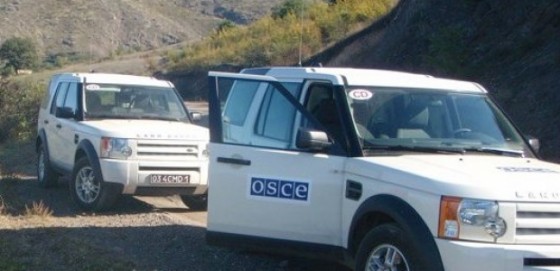
The ceasefire was violated during the OSCE monitoring along the line of contact of Azerbaijani and Armenian troops on October 27.
“This violence was aimed at undermining the progress towards the settlement of the Nagorno-Karabakh conflict,” the OSCE statement said Oct. 29.
“This incident represents a deliberate effort to undermine progress towards a settlement,” the statement said. “It also underscores the need for the OSCE to have the ability to investigate violations of the ceasefire.”
The monitoring was held under the mandate of personal representative of the OSCE chairperson-in-office in the Terter district of Azerbaijan Oct. 27.
Despite the agreement on the ceasefire, the Armenian armed forces opened fire by using automatic weapons during the monitoring, the Azerbaijani defense ministry said.
The OSCE representatives said that violence along the line of contact and on the Armenian-Azerbaijani border poses a risk, the statement said.
The OSCE representatives stressed to the Presidents the dangers of violence along the Line of Contact and Armenia-Azerbaijan border.
“The use of heavy weapons, such as mortars and rocket launchers, is unacceptable and presents a serious danger to the civilian population,” the statement said. “We deeply regret the casualties and loss of life among innocent civilians and expect the sides to take every step to avoid violence. We raised existing proposals designed to stabilize the security situation and create a more constructive atmosphere for negotiations.”
“We encourage dialogue among all those affected by the conflict as an essential part of the peace process, and support programs that bring Armenians and Azerbaijanis together,” the statement said. “We also met with the representative of the International Committee of the Red Cross in Yerevan to discuss the implementation of a data exchange on missing persons, a humanitarian measure we fully support.”
The Co-Chairs of the OSCE Minsk Group (Ambassadors Igor Popov of the Russian Federation, James Warlick of the United States of America, and Pierre Andrieu of France), together with the Personal Representative of the OSCE Chairman-in-Office Ambassador Andrzej Kasprzyk, traveled to the region October 26-28.
The OSCE representatives met with the presidents and foreign ministers of Armenia and Azerbaijan, as well as the de facto authorities of Nagorno-Karabakh.
The presidents confirmed their commitment to hold a summit under the auspices of the Co-Chairs before the end of the year to discuss key elements of a settlement and other issues, the statement said.
The conflict between the two South Caucasus countries began in 1988 when Armenia made territorial claims against Azerbaijan. As a result of the ensuing war, in 1992 Armenian armed forces occupied 20 percent of Azerbaijan, including the Nagorno-Karabakh region and seven surrounding districts.
The two countries signed a ceasefire agreement in 1994. The co-chairs of the OSCE Minsk Group, Russia, France and the US are currently holding peace negotiations.
Armenia has not yet implemented the UN Security Council’s four resolutions on the liberation of the Nagorno-Karabakh and the surrounding regions.
follow the author on Twitter:@E_Kosolapova
Trend
